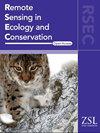Interannual spectral consistency and spatial uncertainties in UAV‐based detection of boreal and subarctic mire plant communities
IF 4.3
2区 环境科学与生态学
Q1 ECOLOGY
引用次数: 0
Abstract
Unoccupied Aerial Vehicle (UAV) imagery is widely used for detailed vegetation modeling and ecosystem monitoring in peatlands. Despite high‐resolution data, the spatial complexity and heterogeneity of vegetation, along with temporal fluctuations in spectral reflectance, complicate the assessment of spatial patterns in these ecosystems. We used interannual multispectral UAV data, collected at the same time of the year, from two aapa and two palsa mires in Finland. We applied Random Forest classification to map plant communities and assessed spectral, temporal and spatial consistency, class relationships and area estimates. Further, we used the class membership probabilities from the classification to derive a secondary classification map, representing the second most likely class label per‐pixel and an alternative map to account for spatial uncertainty in area estimates. The accuracies of the primary classifications varied between 66 and 85%. The best results were achieved using interannual data, improving accuracy by up to 14%‐points when compared to single‐year imagery, particularly benefiting classes with lower accuracies. Spectral and temporal inconsistencies in the UAV data collected in different years led to variations in the classifications, notably for the基于无人机的北方和亚北极沼泽植物群落探测的年际光谱一致性和空间不确定性
无人机(UAV)图像被广泛用于泥炭地植被精细建模和生态系统监测。尽管有高分辨率的数据,但植被的空间复杂性和异质性,以及光谱反射率的时间波动,使这些生态系统空间格局的评估复杂化。我们使用了每年同一时间从芬兰的两个aapa和两个palsa沼泽收集的年际多光谱无人机数据。我们采用随机森林分类方法绘制植物群落图,并评估光谱、时空一致性、类关系和面积估算。此外,我们使用分类中的类别隶属概率来导出二级分类图,代表每像素第二可能的类别标签和替代图,以解释面积估计中的空间不确定性。主要分类的准确率在66%到85%之间。使用年际数据获得了最好的结果,与单年图像相比,精度提高了14%,特别是对精度较低的班级有利。不同年份收集的无人机数据的光谱和时间不一致导致了分类的变化,特别是对于palsa沼泽中的Rubus chamaemorus群落,可能是由于天气波动和物候。在高度不确定的领域,从初级分类到二级分类的转换与混淆矩阵中的类关系很好地一致,支持模型的可靠性。基于置信区间的调整估计值与替代地图的未调整面积估计值基本一致。我们的研究结果支持结合类隶属概率和替代地图来捕捉空间上明确的不确定性,特别是当空间变异性很高或涉及关键植物群落时。我们提出的方法特别有利于生态过程的升级,例如碳通量,其中空间变异性由植物群落分布驱动,并且知情决策需要详细的空间评估。
本文章由计算机程序翻译,如有差异,请以英文原文为准。
求助全文
约1分钟内获得全文
求助全文
来源期刊

Remote Sensing in Ecology and Conservation
Earth and Planetary Sciences-Computers in Earth Sciences
CiteScore
9.80
自引率
5.50%
发文量
69
审稿时长
18 weeks
期刊介绍:
emote Sensing in Ecology and Conservation provides a forum for rapid, peer-reviewed publication of novel, multidisciplinary research at the interface between remote sensing science and ecology and conservation. The journal prioritizes findings that advance the scientific basis of ecology and conservation, promoting the development of remote-sensing based methods relevant to the management of land use and biological systems at all levels, from populations and species to ecosystems and biomes. The journal defines remote sensing in its broadest sense, including data acquisition by hand-held and fixed ground-based sensors, such as camera traps and acoustic recorders, and sensors on airplanes and satellites. The intended journal’s audience includes ecologists, conservation scientists, policy makers, managers of terrestrial and aquatic systems, remote sensing scientists, and students.
Remote Sensing in Ecology and Conservation is a fully open access journal from Wiley and the Zoological Society of London. Remote sensing has enormous potential as to provide information on the state of, and pressures on, biological diversity and ecosystem services, at multiple spatial and temporal scales. This new publication provides a forum for multidisciplinary research in remote sensing science, ecological research and conservation science.
 求助内容:
求助内容: 应助结果提醒方式:
应助结果提醒方式:


